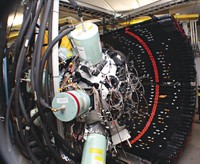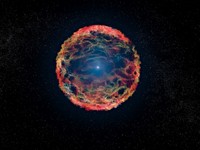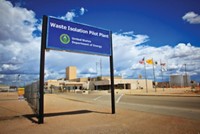Advertisement
Grab your lab coat. Let's get started
Welcome!
Welcome!
Create an account below to get 6 C&EN articles per month, receive newsletters and more - all free.
It seems this is your first time logging in online. Please enter the following information to continue.
As an ACS member you automatically get access to this site. All we need is few more details to create your reading experience.
Not you? Sign in with a different account.
Not you? Sign in with a different account.
ERROR 1
ERROR 1
ERROR 2
ERROR 2
ERROR 2
ERROR 2
ERROR 2
Password and Confirm password must match.
If you have an ACS member number, please enter it here so we can link this account to your membership. (optional)
ERROR 2
ACS values your privacy. By submitting your information, you are gaining access to C&EN and subscribing to our weekly newsletter. We use the information you provide to make your reading experience better, and we will never sell your data to third party members.
Environment
Lab In A Mine
Construction of facility for physics and other experiments in former gold mine might start in 2014
by Jyllian N. Kemsley
October 4, 2010
| A version of this story appeared in
Volume 88, Issue 40
The Homestake mine in Lead, S.D., was once the largest, deepest, and most productive gold mine in North America. Next year, the National Science Board (NSB) will likely decide whether to go forth with a project to turn the site into the largest and deepest underground laboratory in the world—the Deep Underground Science & Engineering Lab (DUSEL).
The deepest lab in the facility will sit about 2,250 meters (1.4 miles) below the surface; researchers will be able to drill down even farther. Geologists want to use the underground location to look at subsurface processes such as rock deformation. Biologists are interested in microbes that both inhabit the mine and exist in unperturbed rock. But the driving force behind DUSEL’s development is physicists who would like to take advantage of the quiet, low-radiation environment to get a better idea of the characteristics of fundamental particles that make up the universe.
Many of the proposed physics projects involve neutrinos, the chargeless elementary particles emitted in some types of radioactive decay. Researchers want to try to pin down the masses of the three different kinds of neutrinos, as well as to figure out whether neutrinos and their antimatter counterparts, antineutrinos, are actually the same thing. To do the latter, researchers will need to watch for a particular type of neutron decay that has a half-life of more than 1020 years. Going deep underground to eliminate background noise from cosmic rays and common radiation sources such as radon is key to the experiments.
Another area of research proposed for the mine is nuclear astrophysics. Scientists want to track neutrinos emitted by the sun and other stars to gain insight into astral nuclear reactions. They also want to place a small particle accelerator inside the mine to try to re-create those reactions. Last but not least, physicists interested in DUSEL want to look for dark matter by watching for the interaction of a dark-matter particle with an atom.
In addition to going underground to reduce background noise, researchers will also have to reduce the radioactivity in the materials that make up their instruments to conduct their desired experiments. Radioactive isotopes of elements such as uranium, thorium, and potassium can contaminate materials in amounts that, although small, could still generate enough decay events to swamp the signals physicists are looking for. One way to reduce the unwanted radioactive decay is to reengineer instrument components to be smaller and use less material.
In cases where that approach won’t suffice, new materials-processing methods will be needed to produce equipment with three to six orders of magnitude less radioactivity than commonly available components have, says Jason Detwiler, a postdoctoral fellow at Lawrence Berkeley National Laboratory who has been tasked with simulating some of the proposed DUSEL experiments to determine the required materials specifications.
To get the purity of copper needed for structural supports, for example, researchers at Pacific Northwest National Laboratory have been developing methods to electroform highly pure copper. By dissolving the metal in an acid bath and tuning the system’s electrical potentials appropriately, they can plate ultrapure copper while leaving impurities behind in the acid. Even the electroforming process, however, will have to be done deep underground because cosmic rays produce radioactive cobalt-60 from copper.
Some parts of the proposed lab are already open. With support from the South Dakota state government and philanthropist T. Denny Sanford, physicists, geologists, and biologists are already using some upper levels of the former mine for research. University of California, Berkeley, physicist and DUSEL principal investigator Kevin T. Lesko notes that work must be done to make the former mine functional and safe for researchers; groundwater must be pumped out, for example, and elevators maintained. But people are and will be working in stable tunnels that have existed for decades, making for a research environment that is a far cry from ore extraction operations, Lesko says.
Next year, a big decision will need to be made about the full DUSEL facility. Project staff will submit the preliminary design to NSB for review, as part of the National Science Foundation’s Major Research Equipment & Facilities Construction funding process.
The board will then decide whether to go ahead and send DUSEL to the final design stage, with construction targeted to begin in 2014 and experiments coming on-line as early as 2015. Although the original target budget for the project was $750 million, Lesko says that the final request might be for $875 million, including $575 million for facility construction and $300 million for instrumentation. The Department of Energy is stewarding some of the neutrino research and could provide additional support.
Ultimately, the research proposed for the quiet, deep confines of Homestake is very basic, aimed at achieving a better understanding of the world and universe in which we live. But Lesko thinks big things will come out of it: There could be “truly revolutionary discoveries,” Lesko says. “We would have to rewrite textbooks.”






Join the conversation
Contact the reporter
Submit a Letter to the Editor for publication
Engage with us on Twitter